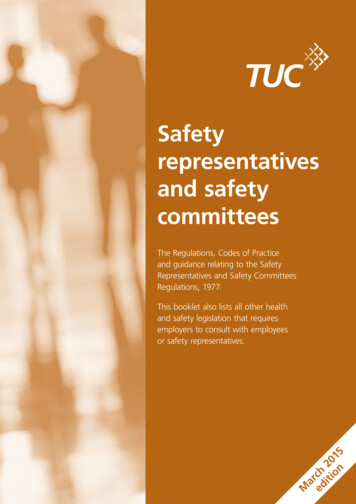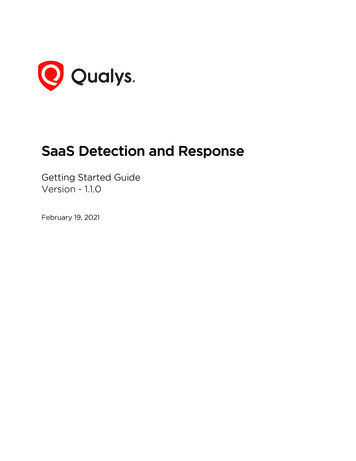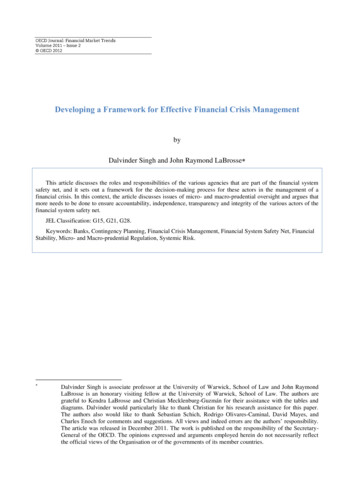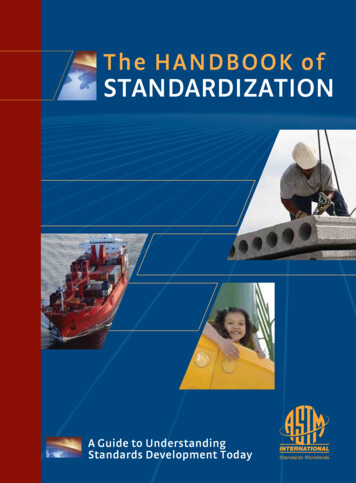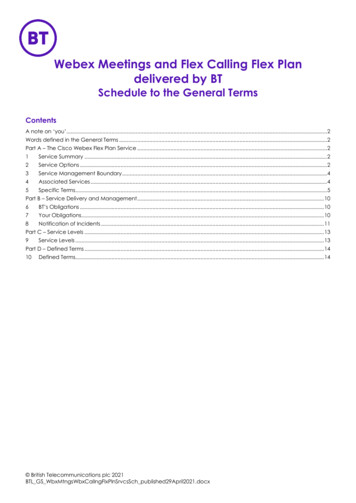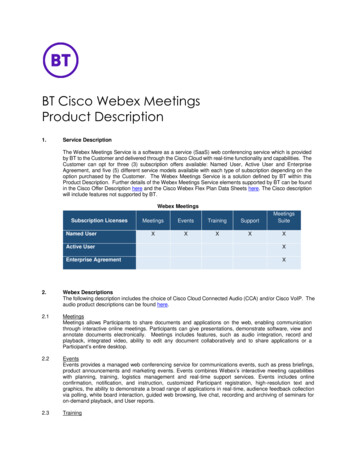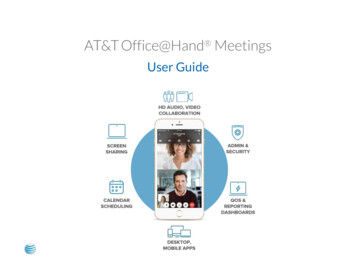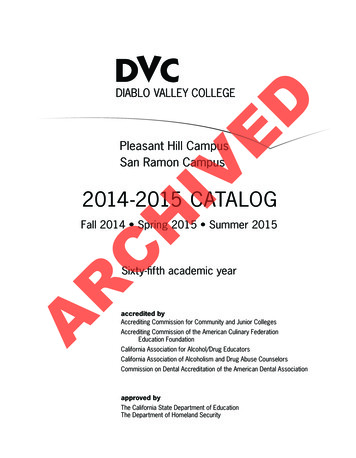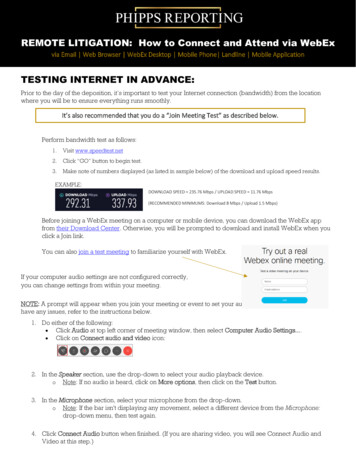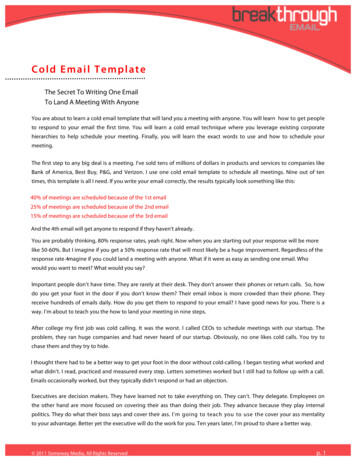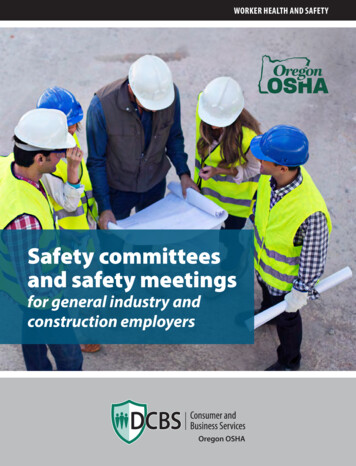
Transcription
WORKER HEALTH AND SAFETYSafety committeesand safety meetingsfor general industry andconstruction employersOregon OSHA
Safety committees and safety meetingsfor general industry and construction employersAbout this guideThis quick guide is an Oregon OSHA Standards and Technical Resources publication.Oregon OSHA quick guides are for employers and employees who want to know aboutour requirements and get back to business – quickly.This guide tells you how to comply with Oregon OSHA’s safety committees andsafety meetings rule: 437-001-0765.Piracy noticeReprinting, excerpting, or plagiarizing this publication is fine with us as long as it’s notfor profit! Please inform Oregon OSHA of your intention as a courtesy.
ContentsWhat businesses must have safety committees or safety meetings?. . . . . . . . . . . . . . . . 2What requirements do I follow? . . . . . . . . . . . . . . . . . . . . . . . . . . . . . . . . . . . . . . . . . . . . . . . . . . . . . . . . . . . . 2Should I have a safety committee or should I have safety meetings? . . . . . . . . . . . . . . . 3My business has 10 or few employees . . . . . . . . . . . . . . . . . . . . . . . . . . . . . . . . . . . . . . . . . . . . . . . . . . . . . . 3My business has more than 10 employees . . . . . . . . . . . . . . . . . . . . . . . . . . . . . . . . . . . . . . . . . . . . . . . . . . 3What if my business has more than one location?. . . . . . . . . . . . . . . . . . . . . . . . . . . . . . . . . . . . . . . . . . . 4What are the options for fire departments?. . . . . . . . . . . . . . . . . . . . . . . . . . . . . . . . . . . . . . . . . . . . . . . . . 4What are the requirements for safety committees?. . . . . . . . . . . . . . . . . . . . . . . . . . . . . . . . . . . 5Who can be a member of my safety committee?. . . . . . . . . . . . . . . . . . . . . . . . . . . . . . . . . . . . . . . . . . . . 5How many members does my safety committee need? . . . . . . . . . . . . . . . . . . . . . . . . . . . . . . . . . . . . . 5What does a safety committee have to do? . . . . . . . . . . . . . . . . . . . . . . . . . . . . . . . . . . . . . . . . . . . . . . . . . 6If you can’t meet Oregon OSHA’s requirements for safety committees, here is an option . . . . . 7What are the requirements for safety meetings?. . . . . . . . . . . . . . . . . . . . . . . . . . . . . . . . . . . . . . 8Who must attend safety meetings?. . . . . . . . . . . . . . . . . . . . . . . . . . . . . . . . . . . . . . . . . . . . . . . . . . . . . . . . . 8How often must we meet?. . . . . . . . . . . . . . . . . . . . . . . . . . . . . . . . . . . . . . . . . . . . . . . . . . . . . . . . . . . . . . . . . 8What are we supposed to do at safety meetings? . . . . . . . . . . . . . . . . . . . . . . . . . . . . . . . . . . . . . . . . . . . 8Are we required to take minutes?. . . . . . . . . . . . . . . . . . . . . . . . . . . . . . . . . . . . . . . . . . . . . . . . . . . . . . . . . . . 8Are safety meetings required at multi-employer worksites? . . . . . . . . . . . . . . . . . . . . . . . . . . . . . . . . . 9If you can’t meet Oregon OSHA’s requirements for safety meetings, here is an option. . . . . . . . 9Safety meeting minutes (form). . . . . . . . . . . . . . . . . . . . . . . . . . . . . . . . . . . . . . . . . . . . . . . . . . . . . . . . . . . . 10Safety committee meeting minutes (form). . . . . . . . . . . . . . . . . . . . . . . . . . . . . . . . . . . . . . . . . . . . . . . . . 11Oregon OSHA Services. . . . . . . . . . . . . . . . . . . . . . . . . . . . . . . . . . . . . . . . . . . . . . . . . . . . . . . . . . . . . . . . . 121
What businesses must have safety committeesor safety meetings?If you’re an employer in Oregon, your business must have a safety committee or have safetymeetings unless you’re the sole owner and the only employee of a corporation.What requirements do I follow?General industry and construction employers: If your employees are covered by OregonOSHA’s general industry rules or construction rules, follow the requirements in 437-001-0765,Safety Committees and Safety Meetings.This guide explains these requirements.Agriculture employers: If your employees are covered by Oregon OSHA’s agriculture rules,follow the requirements in 437-004-0251, Safety Committees and Safety Meetings.Forest activities employers: If your employees are covered by Oregon OSHA’s forest activitiesrules, follow the requirements in 437-007-0130(4), Employee Involvement.2
Should I have a safety committee or should I havesafety meetings?Most businesses can have safety committees or safety meetings. Which of the following appliesto your business?My business has 10 or fewer employees.Your business can have a safety committee or safety meetings. For small businesses, safetymeetings save time and keep paperwork to a minimum.My business has more than 10 employees.Do more thanhalf of youremployees work atconstruction sites?YESNODo morethan half ofyour employeestravel frequentlybetween jobsaway from yourlocation?NOYESDo morethan half ofyour employeeswork in an officeenvironment?NOYESYou can have a safety committeeor safety meetings.Your business must havea safety committee.Generally, businesses that must have safety committees have more than10 employees and are retail or manufacturing establishments.3
What if my business has more than one location?You can have one safety committee or safety meetings at any location that has 10 or feweremployees.Centralized safety committeesYou can also have a centralized safety committee that represents the safety and healthconcerns of employees at all of the locations. A centralized safety committee must follow therequirements in 437-001-0765 and represent employees at all of the locations.An employee from each location does not have to attend a centralized safetycommittee meeting as long as someone at the meeting represents their interests.A centralized safety committee must have a written policy that: States management’s commitment to workplace safety and health. Requires employee involvement and describes what it means. Describes how management will hold everyone in the business accountable forsafety and health. Describes specific methods for identifying and correcting safety and health hazardsat each location. Requires a comprehensive annual review, in writing, of the committee’s activities toenhance workplace safety at all locations.What are the options for fire departments?Fire departments can have safety committees or safety meetings. Fire departments that havemore than one location can have a centralized safety committee that represents the safetyand health concerns of employees at all the locations.4
What are the requirements for safety committees?Read this section if you decide to have a safety committee.See Page 8 if you decide to have safety meetings.Who can be a member of my safety committee?Your safety committee must have an equal number of employer-selected members andemployee-elected (or volunteer) members. An employer-selected member can be a manager, supervisor, or any other employeemanagement chooses to serve on the committee as its representative. Employees can elect another employee or a supervisor to represent them. If everyone on the committee agrees, there can be a majority of employee-electedmembers or volunteers.Your safety committee must not have a majority of employer-selected members.Safety committee members must: Agree on a chairperson. Serve a minimum of one year, when possible. Be compensated at their regular pay rates. Be trained in accident and incident investigation principles and know how to apply them. Be trained in hazard identification. Receive safety committee meeting minutes. Represent the major activities of the company.For help with training employees about accident prevention and hazardidentification, look under “education” on Oregon OSHA’s “safety committees”A-Z topics web page.How many members does my safety committee need?Membership depends on how many employees your business has. If your business has 20 or fewer employees, your committee needs at least two members. If your business has more than 20 employees, your committee needs at least four members.5
What does my safety committee have to do?There are four things your safety committee must do.1. Meet monthly or quarterly, depending on the work that your employees do If your employees do mostly office work, meet quarterly. If your employees do work other than office work, meet monthly.Your safety committee must meet on company time.Your safety committee doesn’t have to meet during a month when you do aquarterly workplace inspection.You can conduct safety committee meetings with a conference call, if necessary.2. Keep a record of each meeting for three yearsKeep the following information at each meeting: Meeting date Attendees’ names Safety and health issues discussed;include hazards involving tools,equipment, the work environment, andwork practices Recommendations for correctinghazards and reasonable deadlines formanagement to respond Name of the person who will follow upon the recommendations All other committee reports, evaluations,and recommendationsYou can keep your meeting minutes on a form like the one on Page 11 in this guide.You can also download them here. (Go to osha.oregon.gov and click on the A-Zpage. Find “Safety committees” and click on “Forms and document samples”)Hazards identified at safety committee meetings must include recommendationsfor correcting them and a correction date.3. Have procedures for workplace safety and health inspectionsYour safety committee must develop procedures for conducting workplace safety and healthinspections that include where the inspections are conducted, who conducts them, and how often.6
See the summary in the table below.Conducting workplace safety and health inspectionsWhere?Who?How often?Primary fixed sitesEmployer and employee representativesQuarterlyOffice environmentsEmployer and employee representativesQuarterlyAuxiliary and satellite sitesEmployer and employee representatives or atrained, designated person at the worksiteQuarterlyMobile worksites, infrequentlyvisited sites, and sites that donot lend themselves to quarterlyinspectionsEmployer and employee representatives or atrained, designated person at the worksiteAs often as thesafety committeedeterminesnecessaryThose who do inspections must be trained in hazard identificationbut do not have to be safety committee members.4. Accomplish these tasks Work with management to establish accident investigation procedures that will identifyhazards and ensure that they are corrected. Establish a system for employees to report hazards to management and suggest how tocorrect hazards. Establish a procedure for reviewing inspection reports and making recommendations tomanagement. Evaluate all accident and incident investigations and recommend how to prevent themfrom happening again. Make safety committee meeting minutes available for all employees to review. Evaluate how management holds employees accountable for working safely andrecommend ways to strengthen accountability. Examples include evaluating theeffectiveness of safety incentives, disciplinary policies, and employee participation inidentifying hazards.If you can’t meet Oregon OSHA’s requirements for safety committees,here is an option:Oregon OSHA may approve a safety committee that doesn’t meet the requirements in437-001-0765, but does satisfy the intent of the requirements. You must apply to OregonOSHA for approval. Call the Oregon OSHA Standards and Technical Resources Section,503-378-3272, for more information.7
What are the requirements for safety meetings?Read this section if you decide to have safety meetings. These safety meetings arenot the same as a safety committee’s monthly or quarterly meetings. See Page 5 ifyou decide to have a safety committee.Who must attend safety meetings?All available employees must attend safety meetings. At least one person must havemanagement authority to ensure that hazards discussed are corrected.Safety meetings must be held on company time and employees paid their regularrate of pay.How often must we meet?You must have safety meetings monthly or quarterly depending on what yourbusiness does. If you have construction workers: Meet at least monthly and meet before thestart of each job that lasts more than one week. If your employees do mostly office work: Meet at least quarterly. All other employers: Meet at least monthly.What are we supposed to do at safety meetings?Safety meetings must include discussions of: Employees’ concerns about workplace safety or health conditions Accident investigations, causes, and suggested corrective measuresAre we required to keep minutes at safety meetings?If your employees do construction, utility work, or manufacturing, you must keep minutes of allsafety meetings for three years.All other employers: You do not have to keep minutes as long as all your employees attend themeetings. However, you must keep minutes at meetings when any employee is absent.8
Keep the following information at each meeting: Meeting date Attendees’ names Safety and health issues discussed; include hazards involving tools, equipment, the workenvironment, and work practicesYou can keep your meeting minutes on a form like the one on Page 10 in this guide.You can also download them here. (Go to osha.oregon.gov and click on the A-Zpage. Find “Safety committees” and click on “Forms and document samples”)Are safety meetings required at multi-employer worksites?If your employees attend the prime contractor’s safety meetings, you do not have to separatesafety meetings for your employees.Keep the minutes from the prime contractor’s safety meetings for three yearsas a part of your records.You must still meet with your employees to discuss any accidents involving them.If you can’t meet OregonOSHA’s requirements for safetymeetings, here is an option:We may approve safety meetings thatdon’t meet the specific requirements in437-001-0765, but do satisfy the intentof the requirements. You must applyto Oregon OSHA for approval. Call theOregon OSHA Standards and TechnicalResources Section, 503-378-3272, formore information.9
Safety meeting minutes (form)Before you begin. If your employees do construction, utility work, or manufacturing, you must keep minutesof all your safety meetings for three years. All other employers: You don’t have to keep minutes if all your employees attend themeetings. However, you must keep minutes at meetings when any employee is absent.Date of today’s meeting: / /Keep until: / /(Keep three years)AttendingAbsentWhat are the issues and hazards?Write down any safety or health issues that you talk about. Include recent accident investigationsand hazards involving tools, equipment, the work environment, and work practices.10
Safety committee meeting minutes (form)Date of today’s meeting: / /Keep until: / /(Keep three years)AttendingAbsentWhat are the issues and hazards?Include any safety or health issues that you talk about. Include recent accident investigationsand hazards involving tools, equipment, the work environment, and work practices.Recommendations for correcting hazardsInclude recommendations for correcting hazards and reasonable deadlines formanagement to respond.RecommendationsDeadline for responsePerson who will follow up on recommendations:11
Oregon OSHA ServicesOregon OSHA offers a wide variety of safety and health services to employers and employees:Appeals 503-947-7426; 800-922-2689; admin.web@oregon.gov Provides the opportunity for employers to hold informal meetings with Oregon OSHA onconcerns about workplace safety and health. Discusses Oregon OSHA’s requirements and clarifies workplace safety or health violations. Discusses abatement dates and negotiates settlement agreements to resolve disputedcitations.Conferences 503-378-3272; 888-292-5247, Option 1; oregon.conferences@oregon.gov Co-hosts conferences throughout Oregon that enable employees and employers to learnand share ideas with local and nationally recognized safety and health professionals.Consultative Services 503-378-3272; 800-922-2689; consult.web@oregon.gov Offers no-cost, on-site safety and health assistance to help Oregon employers recognizeand correct workplace safety and health problems. Provides consultations in the areas of safety, industrial hygiene, ergonomics, occupationalsafety and health programs, assistance to new businesses, the Safety and HealthAchievement Recognition Program (SHARP), and the Voluntary Protection Program (VPP).Enforcement 503-378-3272; 800-922-2689; enforce.web@oregon.gov Offers pre-job conferences for mobile employers in industries such as logging andconstruction. Inspects places of employment for occupational safety and health hazards and investigatesworkplace complaints and accidents. Provides abatement assistance to employers who have received citations and providescompliance and technical assistance by phone.Public Education 503-947-7443; 888-292-5247, Option 2; ed.web@oregon.gov Provides workshops and materials covering management of basic safety and healthprograms, safety committees, accident investigation, technical topics, and job safety analysis.12
Oregon OSHA ServicesStandards and Technical Resources 503-378-3272; 800-922-2689; tech.web@oregon.gov Develops, interprets, and gives technical advice on Oregon OSHA’s safety and health rules. Publishes safe-practices guides, pamphlets, and other materials for employers andemployees. Manages the Oregon OSHA Resource Center, which offers safety videos, books, periodicals,and research assistance for employers and employees.Need more information? Call your nearest Oregon OSHA office.Salem Central Office350 Winter St. NE, Room 430Salem, OR 97301-3882Phone: 503-378-3272Toll-free: 800-922-2689Fax: 503-947-7461en Español: 800-843-8086Web site: osha.oregon.govBendRed Oaks Square1230 NE Third St., Suite A-115Bend, OR 97701-4374541-388-6066Consultation: 541-388-6068Eugene1500 Valley River Drive, Suite 150Eugene, OR 97401-4643541-686-7562Consultation: 541-686-7913Medford1840 Barnett Road, Suite DMedford, OR 97504-8250541-776-6030Consultation: 541-776-6016Pendleton200 SE Hailey Ave.Pendleton, OR 97801-3056541-276-9175Consultation: 541-276-2353PortlandDurham Plaza16760 SW Upper Boones Ferry Road, Suite 200Tigard, OR 97224-7696503-229-5910Consultation: 503-229-6193Salem1340 Tandem Ave. NE, Suite 160Salem, OR 97301503-378-3274Consultation: 503-373-781913
Salem Central Office350 Winter St. NESalem, OR 97301-3882Phone: 503-378-3272Toll-free: 800-922-2689Fax: 503-947-7461en Español: 800-843-8086440-0989 (2/18/COM)Website: osha.oregon.gov
Examples include evaluating the effectiveness of safety incentives, disciplinary policies, and employee participation in identifying hazards. If you can't meet Oregon OSHA's requirements for safety committees, here is an option: Oregon OSHA may approve a safety committee that doesn't meet the requirements in :
